Matcha tea originated in China and gained cultural prominence in Japan. Beyond tradition, matcha has become a global favorite, celebrated for its unique taste and health benefits.
But do you know what is matcha tea? Matcha tea is a finely ground, vibrant green powdered tea made from shade-grown tea leaves, known for its unique flavor, rich cultural significance, and health benefits.
It is similar to green tea but grown differently to yield a unique nutrition profile. Matcha tea is a rich source of vitamins, with super antioxidants and amino acids such as L-theanine.
Origins and Production of Matcha
Matcha dates back nearly a thousand years to when dynasties ruled China and Shogun clans ruled Japan. Match tea symbolizes tradition and culture that has been cherished for centuries. Its unique flavor and health benefits have made it popular worldwide, and people are discovering the nutritious benefits of this delicious tea.
So, what is matcha powder? Explore the historical roots and cultivation process to learn more about Matcha tea.
Historical Roots of Matcha
The history of green tea in China dates back to the 8th century, the Tang Dynasty, which incorporated it into meditation rituals. The discovery of grinding tea leaves into a powder originated with the Chinese. This powdered tea, referred to as “Luo cha” in Chinese, held significant value for its medicinal properties and was favored by emperors and nobility in ancient China.
During the 12th century, Eisai, a Japanese Buddhist monk, traveled to China to discover the matcha green tea. He brought tea seeds and knowledge of cultivating and processing matcha back to Japan. Gradually, Match became an integral part of the Japanese tea ceremonies with deep ties to Zen Buddhism. Matcha’s preparation and consumption evolved into a ritualistic practice, following the principles of harmony, respect, and tranquility.
Today, Matcha is consumed worldwide due to its distinct flavor and health benefits. The latest trends in the tea sector indicate that health enthusiasts and consumers recognize Matcha for its rich concentration of antioxidants, vitamins, and minerals.
Beyond traditional tea consumption, it has found diverse culinary applications, enhancing desserts, smoothies, and savory dishes. Whether savored in a classic tea ceremony or integrated into contemporary dishes, matcha remains an intriguing choice, with its exceptional flavor and health-promoting properties.
Growing and Harvesting
All tea, whether green, oolong, black, or even matcha, comes from the camellia Sinensis plant. Japanese tea farmers are the exclusive producers of authentic matcha powder.
Here’s a step-by-step process for growing and harvesting a Matcha tea plant:
1. Shade grown
Matcha tea plants are shaded for about 20-30 days before harvest, enhancing chlorophyll and amino acid content. This process is known as “tana”. The absence of direct sunlight promotes tender, flavorful leaves, leading to matcha’s vibrant green color and unique taste.
2. Hand-picked
Skilled harvesters hand-pick the tenderest leaves, ensuring quality and minimizing damage to the tea plant.
3. Steamed and air-dried
The freshly picked leaves undergo immediate steaming to halt fermentation. Afterward, they are air-dried to preserve color, flavor, and nutritional content.
4. De-stemmed and graded
Stems are removed to improve the final texture and flavor. Leaves are then sorted and graded based on quality, with only the finest selected for matcha production.
5. Grounded into Matcha
The selected leaves are stone-ground into a fine powder using traditional methods, creating the vibrant and flavorful matcha used in tea ceremonies and culinary applications.
Moreover, Matcha is also grown via Urban Farming in Southeast Asia, providing controlled environments, such as indoor or greenhouse settings, to enable the cultivation of tea plants in urban areas. Urban farmers can produce high-quality matcha with proper care, shading, and harvesting techniques, contributing to sustainable and local tea production.
Types of Matcha
There are primarily two types: ceremonial grade and culinary grade.
1. Ceremonial Grade
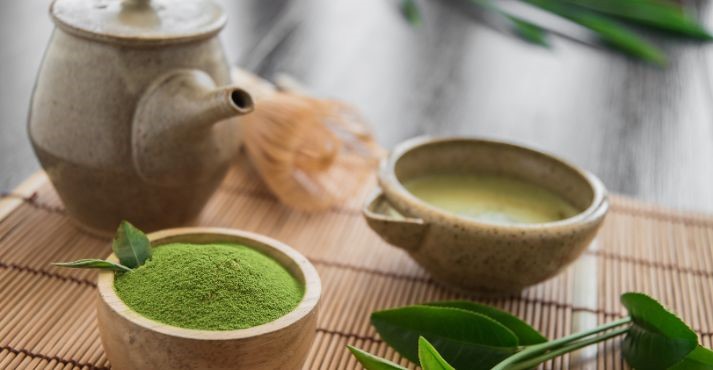
Ceremonial grade matcha is the highest quality matcha for traditional tea ceremonies. It has a full-bodied, creamy flavor with a slight hint of sweetness. It is often pricier and used for drinking.
Ceremonial matcha has a vibrant, emerald green color, a velvety texture, and a delicate, complex flavor profile. The leaves are carefully shade-grown to enhance chlorophyll and amino acids, contributing to its premium quality.
As we explore its cultural significance, Japanese tea ceremonies use ceremonial grade matcha to symbolize respect, harmony, and a connection to nature. It is a key element in the ceremonial preparation and consumption of tea, reflecting the principles of Zen Buddhism.
Common uses of ceremonial grade matcha:
- Traditional tea ceremonies in the revered Japanese tea ceremony
- It is often prepared as a thick, frothy beverage
- Ceremonial matcha emphasizes mindfulness, meditation, and reflection
2. Culinary Grade
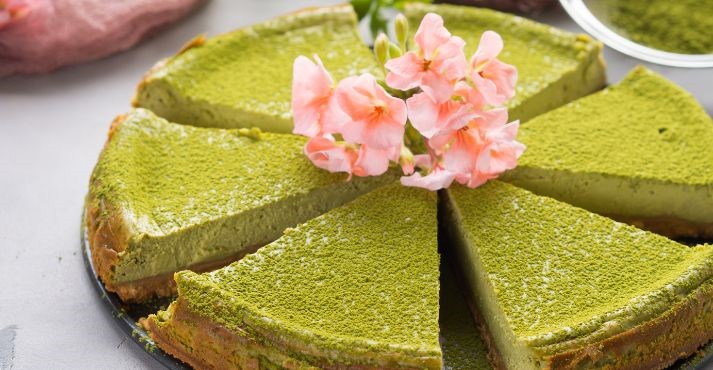
Culinary grade matcha is a slightly lower grade of matcha than ceremonial grade matcha. While not as refined, it is valued for flavor and versatility in cooking and baking.
Features of culinary-grade matcha tea powder:
- Coarser grind
- Darker green color
- Pronounced, astringent flavor
- Versatile for cooking and baking
- An affordable option for culinary use
Culinary-grade matcha finds versatile applications in cooking and baking. Its flavor enhances various dishes, from desserts like cakes and cookies to savory recipes like sauces and marinades.
How to Make Matcha Tea: Step-by-Step Guide
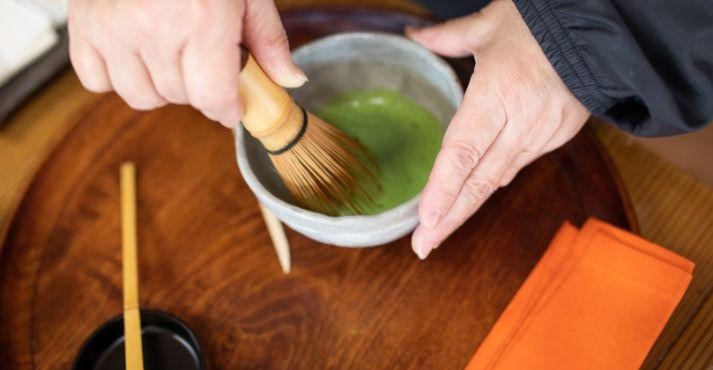
Making matcha tea is both an art and a science. The preparation process requires a few specialized tools and careful attention to detail, but once you master the technique, you can create a delicious, frothy cup of matcha at home. Follow this matcha tea recipe to experience this classic Japanese beverage’s traditional flavor and texture.
Essential Tools and Ingredients
Before diving into the preparation process, gathering the necessary tools and ingredients is essential. Traditional matcha tea preparation calls for a few key items:
- Matcha Bowl (Chawan): A small, wide bowl used to whisk and serve the tea.
- Bamboo Whisk (Chasen): A finely crafted bamboo whisk mixes the matcha powder and water to create a smooth, frothy consistency.
- Sifter: A fine-mesh sifter is essential for removing clumps from the matcha powder to ensure a smooth texture.
- Bamboo Scoop (Chashaku): A small scoop used to measure the correct amount of matcha powder.
- High-quality Matcha Powder: For the best flavor and health benefits, using high-quality ceremonial-grade matcha is essential.
- Hot Water: The water should be around 70-80 degrees Celsius (158-176 degrees Fahrenheit) to avoid burning the delicate tea powder.
You can prepare your matcha tea once you have these tools and ingredients.
Matcha Tea Preparation Process
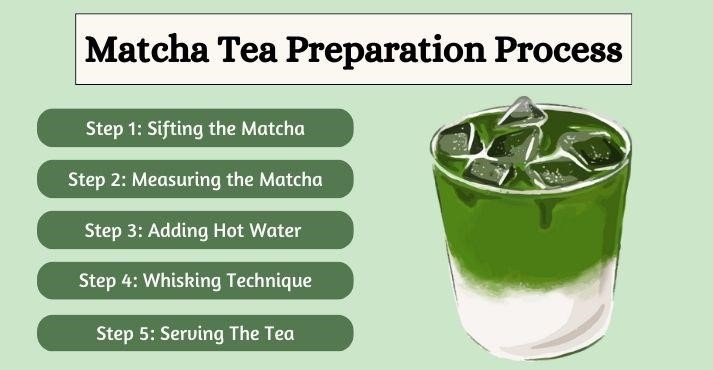
The process of making matcha tea is simple but careful. Here’s a step-by-step guide to help you create the perfect cup of matcha:
Step 1: Sifting the Matcha
Before adding the matcha powder to your bowl, it’s essential to sift it to prevent clumps and ensure a smooth texture.
Because of its fine consistency, matcha powder clumps quickly, making whisk the tea properly challenging. Sifting the matcha creates a lighter, more even powder that blends smoothly with water.
How to sift: Place a small amount of matcha powder (about 1-2 grams) into a fine mesh sifter. Use a spoon or the back of the bamboo scoop to gently push the powder through the mesh into your matcha bowl.
This step is crucial for achieving the silky, smooth texture that matcha tea is known for.
Step 2: Measuring the Matcha
The amount of matcha powder you use depends on how strong you want the tea to be. Typically, a traditional serving of tea calls for 1-2 grams of matcha powder (about half to one teaspoon).
Standard measurements:
- Usucha (thin matcha): Use about 1 gram (half a teaspoon) of matcha powder.
- Koicha (thick matcha): Use 2 grams (a full teaspoon) of matcha powder for a more intense flavor.
Using the bamboo scoop, measure your desired matcha powder and place it into the bowl. A standard kitchen teaspoon can also work if you don’t have a bamboo scoop.
Step 3: Adding Hot Water
Next, it’s time to add hot water to the matcha powder. The temperature of the water is very important—too hot, and you risk burning the matcha, resulting in a bitter flavor. The ideal water temperature for matcha tea is between 70-80 degrees Celsius (158-176 degrees Fahrenheit)
How much water to use: Add a small amount (about 2-3 tablespoons) to the matcha powder. This helps create a paste that will make it easier to whisk the tea later on. Once you’ve mixed the paste, add about 60-70 ml (2-3 ounces) of water for a standard serving of usucha (thin matcha).
If you’re making koicha (thick matcha), use less water—around 40 ml (1.5 ounces)—to create a denser consistency.
Step 4: Whisking Technique
The whisking technique is key to creating the smooth, frothy texture that is characteristic of a well-prepared cup of matcha tea. The goal is to fully dissolve the powder into the water while incorporating air to create a frothy, creamy top.
Whisking process: Hold the bamboo whisk with your dominant hand and the matcha bowl with your other hand. Whisk the matcha quickly, back-and-forth, forming an “M” or “W” shape. The whisk should barely touch the bottom of the bowl as you mix. This vigorous whisking motion helps create a light, frothy foam on the surface of the tea.
The whisking process should take about 15-20 seconds or until the tea has a smooth, even consistency with no lumps or undissolved powder. The result should be a bright green, frothy cup of matcha.
Step 5: Serving Suggestions
Once you’ve whisked your matcha tea perfectly, it’s time to enjoy it! Matcha is traditionally served on its own, but you can elevate the experience by pairing it with a small, sweet treat like wagashi, a traditional Japanese confectionery.
Serving ideas:
- Serve your matcha tea alongside a piece of mochi or sweet rice cakes to balance the tea’s slightly bitter flavor.
- If you prefer something more contemporary, try a matcha latte by adding milk to the tea for a creamy, comforting drink.
For a more authentic experience, enjoy your matcha with a traditional Japanese meal or as part of a relaxing afternoon tea ritual.
Health Benefits of Matcha
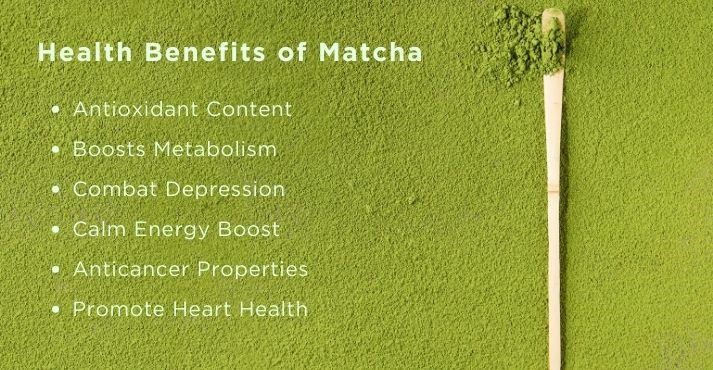
Shifting consumer expectations and health trends in the beverage sector drive increased demand for healthier tea options. According to Mordor Intelligence, the health drinks market size is expected to grow from US$ 344.36 billion in 2023 to US$ 408.80 billion by 2028, at a CAGR of 3.49% during the forecast period (2023-2028).
As consumers seek healthier tea choices, matcha stands out for its rich antioxidant content and potential health benefits. Let’s discuss these matcha benefits, as most of them are backed by a research study.
Antioxidant Content
Matcha plants produce higher amounts of chlorophyll and amino acid L-theanine, leading to elevated antioxidant levels. The leaves boost antioxidant production during shade growth, particularly catechins like epigallocatechin gallate (EGCG). Antioxidants combat oxidative stress, offering potential health benefits such as improved heart health, boosted metabolism, and reduced inflammation.
According to a research study, due to its antioxidant properties, matcha tea can prevent cognitive impairment as a result of oxidative damage. Matcha can also protect the integrity of the antioxidant systems in the liver, brain, and blood, preventing cognitive damage.
Boosts Metabolism
Matcha tea enhances metabolism by combining caffeine and antioxidants, particularly catechins like EGCG. Caffeine boosts energy expenditure, while catechins support fat oxidation.
It helps in weight management by promoting calorie burning and fat breakdown. Additionally, matcha tea’s effects on metabolism appear more stable than coffee’s, with the amino acid L-theanine providing a balanced energy boost.
Moreover, Matcha fermented tea contains vitamins, amino acids, and other nutrients to support a healthy gut microbiome and improve digestion.
Combat Depression
Matcha tea powder has an antidepressant effect by activating the brain’s dopaminergic system. In a new study published in the Journal, Nutrients, Japanese researchers reported that Match tea powder activates dopaminergic neural networks, improves depressive symptoms, and has various physiological benefits.
Calm Energy Boost
Matcha tea’s distinctive blend of caffeine and L-theanine creates a unique synergy. While caffeine boosts energy, L-theanine, an amino acid, promotes relaxation and reduces the jittery effects often associated with caffeine consumption.
This combination results in sustained, focused energy without the sudden peaks and crashes, offering a smoother and more balanced experience than other caffeine sources, like coffee.
Anticancer Properties
According to an NLM research study, matcha tea is attributed to its high content of antioxidant and anti-inflammatory substances that are associated with protective effects against cancer. This specialty tea is rich in antioxidants, particularly EGCG, which may help prevent cell damage and inhibit the growth of cancer cells.
Promote Heart Health
Matcha tea may support heart health due to its high antioxidant content, particularly catechins. These compounds help lower blood pressure, reduce cholesterol levels, and improve cardiovascular function. Moreover, Matcha tea helps prevent clots and relieves blood pressure due to its blood-thinning effects.
Tips for Buying and Storing Matcha
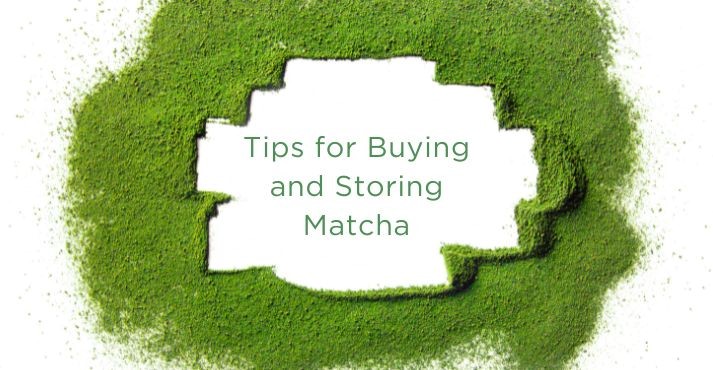
Matcha tea is everywhere now. With its striking color and refreshing flavor, you must know how to choose the best quality Matcha tea.
7 Tips to choose and buy the best quality Matcha tea:
1. Origin
Check for information on the origin of the matcha tea plant. Japanese regions like Uji and Nishio are renowned for producing premium matcha due to ideal growing conditions. Always look for pure, radiation-free, lead-free matcha tea from a single origin.
2. Grade Matters
Choose a high-quality matcha tea, ceremonial or culinary grade, for the best flavor. Ceremonial grade is the finest, while culinary is suitable for cooking.
3. Vibrant Green Color
Quality matcha tea is vibrant green, indicating proper shading during growth. Avoid dull or yellowish hues, which may signify lower-grade or aged matcha.
4. Texture
Feel the texture of the matcha tea powder. Finer particles suggest a higher quality. A smooth, velvety texture gives a more authentic matcha tea experience.
5. Aroma Check
High-quality matcha tea has a fresh, grassy aroma. Avoid matcha tea with a stale or musty smell, which indicates poor quality or improper storage.
6. Packaging Quality
Choose matcha packaged in airtight, light-resistant containers to preserve freshness. Quality packaging protects the matcha from air, light, and moisture.
7. Read Reviews
Research online and read reviews from reliable sources such as online product review platforms, social media, and websites.
Now that you know how to use matcha powder and use it for various health benefits, you must store it properly to maintain long-lasting freshness and quality.
Here are some tips on Matcha tea storage to maintain freshness and flavor:
- Airtight Container: Store matcha tea in an airtight container to protect it from exposure to air, moisture, and odors. This helps maintain its freshness and prevents it from absorbing unwanted flavors.
- Cool and Dark Environment: Keep matcha tea away from direct sunlight and store it in a cool, dark place. Exposure to light and heat can degrade the quality of matcha and affect its flavor.
- Refrigeration: While not necessary, storing matcha tea in the refrigerator can extend its shelf life. Ensure the container is airtight to prevent moisture from affecting the powder. Allow it to come to room temperature before use.
- Avoid Strong Odors: Matcha tea easily absorbs odors from its surroundings. Store it away from strong-smelling items like spices or coffee to preserve its delicate flavor.
- Use Quickly After Opening: Use the matcha tea powder within a few weeks to enjoy its freshness. Over time, exposure to air can lead to a decline in flavor and quality.
- Quality Packaging: Choose varieties in well-sealed, airtight packaging when purchasing matcha. High-quality packaging helps protect the matcha tea from external factors that can compromise its taste and aroma.
Potential Side Effects and Considerations
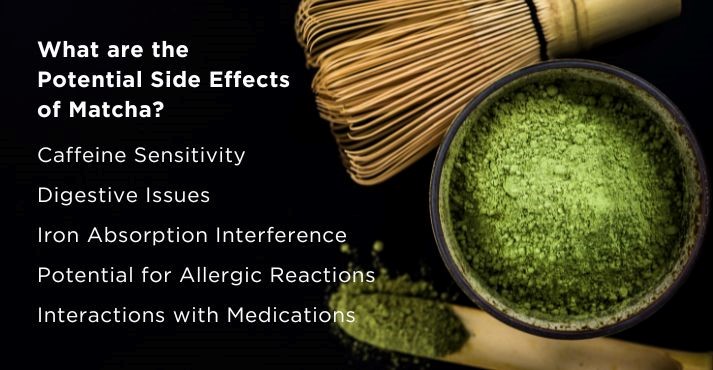
Matcha tea has few to no side effects. However, matcha may have side effects like any food or beverage, particularly for individuals sensitive to caffeine.
Here are some common potential side effects and considerations:
Caffeine Sensitivity
Matcha tea contains caffeine, and excessive consumption may lead to side effects such as insomnia, nervousness, restlessness, and increased heart rate.
Individuals sensitive to caffeine, pregnant women, and those with cardiovascular issues should moderate their matcha intake. Opting for lower-caffeine alternatives or choosing decaffeinated matcha may be advisable.
Digestive Issues
Some individuals may experience digestive issues like upset stomach or diarrhea, especially when consuming matcha tea on an empty stomach. Individuals with gastrointestinal sensitivities should monitor their reactions and adjust their intake.
Iron Absorption Interference
Matcha tea contains tannins that might interfere with the absorption of non-heme iron (found in plant-based foods) when consumed simultaneously.
Individuals with iron-deficiency anemia or those who rely on plant-based sources of iron should consume matcha separately from iron-rich meals. This can help mitigate the impact on iron absorption.
Potential for Allergic Reactions
While rare, some individuals may be allergic to components present in matcha tea, leading to symptoms like itching, hives, or swelling. Those with a history of tea allergies or sensitivities should be cautious when trying matcha.
Interactions with Medications
The catechins in matcha tea may interact with certain medications, affecting their absorption or metabolism. Individuals on medications, particularly blood thinners or medications for heart conditions, should consult their healthcare provider before consuming matcha tea regularly.
Remember, moderation is the key, and adjustments should be made based on individual health considerations and reactions.
Frequently Asked Questions (FAQs)
Does matcha have caffiene?
Yes, matcha contains caffeine, but less than most cups of coffee. However, the caffeine in matcha is often balanced by the presence of L-theanine, an amino acid with calming effects.
What does matcha taste like?
Matcha is rich and smooth with a slightly sweet nuttiness and has a pleasant savory taste known as umami. The taste can also be influenced by factors like the quality of the matcha, the region it comes from, and how it’s prepared
Where does matcha come from?
Matcha originated in China and later developed in Japan, where it became deeply rooted in Japanese tea culture. The finest and most traditional matcha is often associated with regions in Japan such as Uji, Nishio, and Shizuoka, which are known for producing high-quality tea leaves for matcha production.
What does matcha look like?
Matcha has a vibrant, bright green color, distinguishing it from other types of green tea. Its powdered form appears as a finely ground, smooth, and green. Matcha typically has a frothy and velvety texture when prepared as a beverage.
What is matcha made from?
Matcha is a powdered green tea made from shade-grown tea leaves. Before harvesting, the plants are covered to enhance chlorophyll content, resulting in a vibrant green color. After drying, the leaves are stone-ground into a fine powder, creating the potent and flavorful matcha used in traditional Japanese tea ceremonies.
Conclusion
Matcha tea stands out as a superfood, packed with high levels of antioxidants, vitamins, and minerals. Its potential health benefits, including improved metabolism, heart health, and a calming energy boost, have fueled its global popularity.
The cultural significance of matcha, deeply rooted in Japanese traditions, adds prominence to its consumption. Whether enjoyed in a traditional tea ceremony or incorporated into modern recipes, matcha continues to captivate enthusiasts with its unique flavor profile and holistic health advantages.
Moreover, as the trends in Asia’s food and beverage industry indicate increasing health-conscious consumers and changing preferences, there’s a growing interest in products that promote health and wellness, making Matcha an ideal match for different dietary choices.
However, moderation is important due to its caffeine content, and potential risks may arise from excessive consumption.












